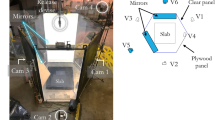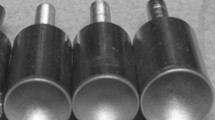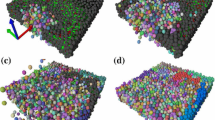Abstract
Three-dimensional discrete element simulations are performed to better understand the impact-induced complex fragmentation process of marble spheres. A 3D clumped particle method is used and a new calibration procedure to match both the quasi-static and dynamic mechanical behaviors of marble is proposed. The impact simulation results show that radial macrocracks occur, which break the intact marble spheres into large orange-slice-shaped fragments. Secondary macrocracks occur for impact velocities larger than 9 m/s, and the fragment size is further reduced. The fracture mechanisms due to local damage, radial, and secondary macrocracks significantly affect the impact process, energy dissipation, evolutions of the masses of the first and second largest fragments, and damage ratio. The numerical model is able to accurately capture all mechanisms, from local damage to disintegration, of the impact-induced fragmentation. Due to local damage and macrocracks, the obtained fragments consist of large and small fragments. The fragment size distributions based on mass and number can be fitted using a generalized extreme value law. The numerical predictions indicate that the translational velocities of some small fragments can be significantly higher than the impact velocity due to the instant high-tensile stress wave near the contact area. The results also suggest that there is no correlation between fragment mass and fragment kinetic energy.













Similar content being viewed by others
Abbreviations
- \(d\) :
-
Characteristic fragment size
- \(d_{\text{a}}\) :
-
Average characteristic size of fragments with a translational velocity larger than the impact velocity
- \(E_{\text{bs}}\) :
-
Shear deformation energy of a parallel bond
- \(E_{\text{bt}}\) :
-
Tensile deformation energy of a parallel bond
- \(E_{\text{c}}\) :
-
Contact modulus
- \(\bar{E}_{\text{c}}\) :
-
Parallel bond contact modulus
- \(E_{\text{cdef}}\) :
-
Contact deformation energy
- \(E_{\text{bdef}}\) :
-
Bond deformation energy
- \(E_{\text{el}}\) :
-
Elastic deformation energy
- \(E_{\text{k}}\) :
-
Total kinetic energy of all particles
- \(E_{\text{k}}^{ + }\) :
-
Total kinetic energy after impact
- \(E_{\text{k}}^{ - }\) :
-
Total kinetic energy before impact
- \(E_{\text{t}}^{ + }\) :
-
Total translational kinetic energy after impact
- \(F\) :
-
Contact force
- \({{k_{\text{n}} } \mathord{\left/ {\vphantom {{k_{\text{n}} } {k_{\text{s}} }}} \right. \kern-0pt} {k_{\text{s}} }}\) :
-
Normal to shear contact stiffness ratio
- \({{\bar{k}_{\text{n}} } \mathord{\left/ {\vphantom {{\bar{k}_{\text{n}} } {\bar{k}_{\text{s}} }}} \right. \kern-0pt} {\bar{k}_{\text{s}} }}\) :
-
Normal to shear parallel bond contact stiffness ratio
- \(M\) :
-
Mass of a fragment
- \(M_{\text{tot}}\) :
-
Total mass of sample
- \(N_{\text{S}}\) :
-
Number of small fragments
- \(N_{\text{L}}\) :
-
Number of large fragments
- \(N_{\text{a}}\) :
-
Number of fragments with translational velocity greater than impact velocity
- \(P\) :
-
Cumulative mass fraction
- \(P_{\text{L}}\) :
-
Cumulative mass fraction for large fragments
- t :
-
Time
- \({\text{TS}}\) :
-
Tensile strength
- \(v_{0}\) :
-
Impact velocity
- \(v_{\text{f}}\) :
-
Translational velocity of fragment
- \(v_{{{\text{fmax}} }}\) :
-
Maximum translational velocity of fragment
- \(v_{\text{fav}}\) :
-
Average translational velocity of fragment
- \({\text{UCS}}\) :
-
Unconfined compressive strength
- \(V_{\text{f}}\) :
-
Volume of a fragment (calculated as the total volume of particles in the fragment)
- \(V_{\text{tot}}\) :
-
Total volume of the numerical sphere sample
- \(W_{\text{f}}^{ + }\) :
-
Energy dissipated by friction after impact
- \(W_{\text{f}}\) :
-
Energy dissipated by friction during impact
- \(W_{\text{fcon}}\) :
-
Friction work from a contact during impact
- \(W_{\text{b}}\) :
-
Energy dissipated by breakage of bonds during impact
- \(W_{\text{b}}^{ + }\) :
-
Energy dissipated by breakage of bonds after impact
- \(\alpha_{\text{d}}\) :
-
Damage ratio (ratio of the number of broken bonds to initial number of bonds)
- \(\alpha_{\text{d}}^{ + }\) :
-
Maximum damage ratio after the impact
- \(\mu\) :
-
Friction coefficient
- \(\bar{\lambda }\) :
-
Parallel bond radius ratio
- \(\lambda\) :
-
Maximum to minimum particle radius ratio
- \(r_{\text{bond}}\) :
-
Parallel bond radius
- \(r_{ \text{min} }\) :
-
Minimum particle radius
- \(\rho\) :
-
Particle density
- \({\text{PN}}\) :
-
Particle number used to create clumps
- \(\alpha ,\beta ,\gamma\) :
-
Parameters for the generalized extreme value distribution
- \(\sigma_{1}\) :
-
Compressive stress
- \(\sigma_{3}\) :
-
Tensile stress
- \(\bar{\sigma }_{\text{c}}\) :
-
Normal strength of parallel bond
- \({{\bar{\tau }_{\text{c}} } \mathord{\left/ {\vphantom {{\bar{\tau }_{\text{c}} } {\bar{\sigma }_{\text{c}} }}} \right. \kern-0pt} {\bar{\sigma }_{\text{c}} }}\) :
-
Shear to normal parallel bond strength ratio
References
Andrews EW, Kim KS (1999) Threshold conditions for dynamic fragmentation of glass particles. Mech Mater 31(11):689–703
Carmona HA, Wittel FK, Kun F et al (2008) Fragmentation processes in impact of spheres. Phys Rev E 77(5):1–10
Chau KT, Wei XX, Wong RHC et al (2000) Fragmentation of brittle spheres under static and dynamic compressions: experiments and analyses. Mech Mater 32(9):543–554
Cho NA, Martin CD, Sego DC (2007) A clumped particle model for rock. Int J Rock Mech Min Sci 44(7):997–1010
Crosta GB, Frattini P, Fusi N (2007) Fragmentation in the Val Pola rock avalanche, Italian Alps. J Geophys Res Earth 112(F01006):1–24
De Blasio FV, Crosta GB (2015) Fragmentation and boosting of rock falls and rock avalanches. Geophys Res Lett 42(20):8463–8470
De Blasio FV, Dattola G, Crosta GB (2018) Extremely energetic rockfalls. J Geophys Res Earth 123(10):2392–2421
Ding X, Zhang L, Zhu H, Zhang Q (2013) Effect of model scale and particle size distribution on pfc3d simulation results. Rock Mech Rock Eng 47(6):1–18
Giacomini A, Buzzi O, Renard B et al (2009) Experimental studies on fragmentation of rock falls on impact with rock surfaces. Int J Rock Mech Min 46(4):708–715
Hogan JD, Rogers RJ, Spray JG et al (2012) Dynamic fragmentation of granite for impact energies of 6–28. J. Eng Fract Mech 79:103–125
Hungr O, Evans SG (2004) Entrainment of debris in rock avalanches: an analysis of a long run-out mechanism. Geol Soc Am Bull 116(9–10):1240–1252
Itasca Consulting Group, Inc. (2004) PFC-Particle Flow Code in 3 Dimensions, Version 3.1, Documentation Set of version 3.1. Itasca Consulting Group, Inc., Minneapolis
Khanal M, Schubert W, Tomas J (2008) Compression and impact loading experiments of high strength spherical composites. Int J Miner Process 86(1):104–113
Kun F, Herrmann HJ (1999) Transition from damage to fragmentation in collision of solids. Phys Rev E 59(3):2623–2632
Manoj K, Wolfgang S, Tomas J (2004) Ball impact and crack propagation-simulations of particle compound material. Granul Matter 5(4):177–184
Metzger MJ, Glasser BJ (2012) Numerical investigation of the breakage of bonded agglomerates during impact. Powder Technol 217:304–314
Mishra BK, Thornton C (2001) Impact breakage of particle agglomerates. Int J Miner Process 61(4):225–239
Moreno R, Ghadiri M, Antony SJ (2003) Effect of the impact angle on the breakage of agglomerates: a numerical study using DEM. Powder Technol 130(1):132–137
Okura Y, Kitahara H, Sammori T et al (2000) The effects of rockfall volume on runout distance. Eng Geol 58(2):109–124
Potyondy DO, Cundall PA (2004) A bonded-particle model for rock. Int J Rock Mech Min 41(8):1329–1364
Ruiz CR, Corominas J, Mavrouli O (2017) A fractal fragmentation model for rockfalls. Landslides 14(3):875–889
Shen W, Zhao T, Crosta GB et al (2017) Analysis of impact-induced rock fragmentation using a discrete element approach. Int J Rock Mech Min 98:33–38
Thornton C, Yin KK, Adams MJ (1996) Numerical simulation of the impact fracture and fragmentation of agglomerates. J Phys D Appl Phys 29(2):424–435
Thornton C, Ciomocos MT, Adams MJ (1999) Numerical simulations of agglomerate impact breakage. Powder Technol 105(1–3):74–82
Timár G, Kun F, Carmona HA et al (2012) Scaling laws for impact fragmentation of spherical solids. Phys Rev E 86(2):1–7
Wang Y (2009) Three-dimensional rock-fall analysis with impact fragmentation and fly-rock modeling. PhD Thesis, University of Austin, Texas
Wang Y, Tonon F (2011a) Discrete element modeling of rock fragmentation upon impact in rock fall analysis. Rock Mech Rock Eng 44(1):23–35
Wang Y, Tonon F (2011b) Dynamic validation of a discrete element code in modeling rock fragmentation. Int J Rock Mech Min 48(4):535–545
Wittel FK, Carmona HA, Kun F et al (2009) Mechanisms in impact fragmentation. Int J Fract 154(1):105–117
Wu S, Xu X (2016) A study of three intrinsic problems of the classic discrete element method using flat-joint model. Rock Mech Rock Eng 49(5):1813–1830
Wu SZ, Chau KT, Yu TX (2004) Crushing and fragmentation of brittle spheres under double impact test. Powder Technol 143–144(25):41–55
Ye Y, Thoeni K, Zeng YW, Buzzi O, Giacomini A (2019a) A 3D clumped particle method to simulate the mechanical response of brittle rock. Int J Rock Mech Min 120:1–16. https://doi.org/10.1016/j.ijrmms.2019.06.002
Ye Y, Zeng YW, Thoeni K, Giacomini A (2019b) An experimental and theoretical study of the normal coefficient of restitution for marble spheres. Rock Mech Rock Eng 52(6):1705–1722
Zhao T, Crosta GB, Utili S et al (2017) Investigation of rock fragmentation during rockfalls and rock avalanches via 3D discrete element analyses. J Geophys Res Earth 122(3):678–695
Zhao T, Crosta GB, Dattola G et al (2018) Dynamic fragmentation of jointed rock blocks during rockslide-avalanches: insights from discrete element analyses. J Geophys Res Sol Earth 123(4):3250–3269
Zheng K, Du C, Li J et al (2015) Numerical simulation of the impact-breakage behavior of non-spherical agglomerates. Powder Technol 286:582–591
Acknowledgements
This work was funded by the National Natural Science Foundation of China (CN) (Grant nos. 41772308). Yang Ye was supported by the China Scholarship Council as a visiting student at the University of Newcastle (Grant nos. 201706270107). This support is gratefully acknowledged. The Newcastle authors also acknowledge support via ARC DP160103140.
Author information
Authors and Affiliations
Corresponding author
Ethics declarations
Conflicts of interest
The authors confirm that they have no known conflicts of interest associated with this publication and no significant financial support for this work could have influenced its outcome.
Additional information
Publisher's Note
Springer Nature remains neutral with regard to jurisdictional claims in published maps and institutional affiliations.
Appendix: Energetic Formulation
Appendix: Energetic Formulation
In the DEM simulations, the energy components can be calculated for each time step. In the following formulation, it is assumed that the potential energy can be neglected, since the impact occurs at a notably small time scale. Hence, gravity is not considered and the total input energy of the numerical model is constant throughout the impact process. In addition, no numerical damping is considered in the impact simulations. The total kinetic energy \(E_{\text{k}}\) of all particles (considering both translational and rotational motion) can be expressed as follows:
where \(n_{\text{p}}\) is the number of particles; \(m_{i}\) and \(I_{i}\) are the mass and moment of inertia of particle \(i\), respectively; and \(v_{i}\) and \(\omega_{i}\) are the translational and rotational velocities of particle \(i\), respectively. When fragmentation occurs during impact, the translational kinetic energy of a fragment can be calculated using the mass and the velocity of the centroid of the fragment. The total kinetic energy of a fragment after impact can be calculated using Eq. (4). The rotational kinetic energy of a fragment can be obtained by subtracting the translational kinetic energy from the total kinetic energy of the fragment. The elastic deformation energy \(E_{\text{el}}\) of the numerical model includes contact deformation energy \(E_{\text{cdef}}\) and bond deformation energy \(E_{\text{bdef}}\). Hence, \(E_{\text{el}}\) can be defined as shown:
According to the linear contact-stiffness model used in this study, the contact deformation energy \(E_{\text{cdef}}\) can be expressed as follows:
where \(n_{\text{c}}\) is the number of contacts; \(\left| {F_{j}^{\text{n}} } \right|\) and \(\left| {F_{j}^{\text{s}} } \right|\) are the magnitudes of the normal and shear components of the contact force, respectively; and \(k^{\text{n}}\) and \(k^{\text{s}}\) are the normal and shear contact stiffnesses, respectively. The bond deformation energy \(E_{\text{bdef}}\) stored in the parallel bonds is expressed as follows:
where \(n_{{p{\text{b}}}}\) is the total number of parallel bonds; \(\left| {\bar{F}_{b}^{\text{n}} } \right|\) and \(\left| {\bar{F}_{b}^{\text{s}} } \right|\) are the normal and shear forces acting in the bond, respectively; \(\left| {\bar{M}_{b}^{\text{n}} } \right|\) and \(\left| {\bar{M}_{b}^{\text{s}} } \right|\) are the normal and shear moments, respectively; \(\bar{k}^{\text{n}}\) and \(\bar{k}^{\text{s}}\) are the normal and shear bond stiffnesses, respectively; \(A\) is the cross-sectional area of the bond; \(I\) is the moment of inertia; and \(J\) is the polar moment of inertia. The shear (\(E_{\text{bs}}\)) and tensile (\(E_{\text{bt}}\)) deformation energies of a parallel bond can be expressed as below:
According to Eq. (7), the energy dissipated by bond breakage \(W_{\text{b}}\) is the sum of the deformation energy of all broken bonds and can be calculated as shown:
where \(n_{\text{bpb}}\) is the number of broken parallel bonds. In addition to \(W_{\text{b}}\), friction work \(W_{\text{f}}\) is another energy dissipation mechanism. Since the loading paths influence the value of friction work, the friction work is given as an incremental formulation:
where \(\left\langle {F_{j}^{\text{s}} } \right\rangle\) and \(\left( {\Delta U_{j}^{\text{s}} } \right)^{\text{slip}}\) are the average shear force and the increment of slip displacement at the contact for the current time step, respectively. The increment of slip displacement is determined by decomposing the total displacement \(\left( {\Delta U_{j}^{\text{s}} } \right)\) into a slip and an elastic portion \(\left( {\Delta U_{j}^{\text{s}} } \right)^{\text{elas}}\), such that the following applies:
where \(v_{j}^{\text{s}}\) is the normal contact velocity with respect to the contact plane.
Rights and permissions
About this article
Cite this article
Ye, Y., Thoeni, K., Zeng, Y. et al. Numerical Investigation of the Fragmentation Process in Marble Spheres Upon Dynamic Impact. Rock Mech Rock Eng 53, 1287–1304 (2020). https://doi.org/10.1007/s00603-019-01972-9
Received:
Accepted:
Published:
Issue Date:
DOI: https://doi.org/10.1007/s00603-019-01972-9




